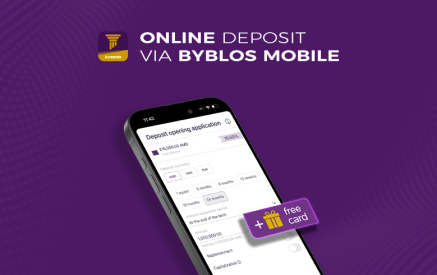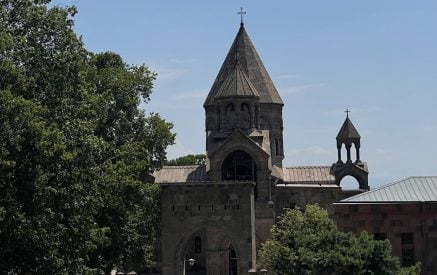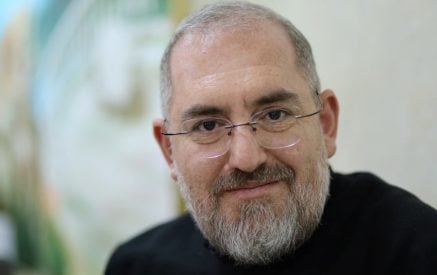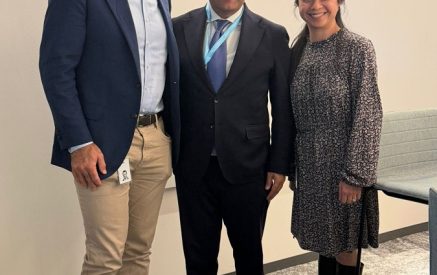BALTIMORE — One hundred years ago, as the members of the fledgling Armenian-American community witnessed the holocaust of their compatriots and families back in Ottoman Turkey, a young woman, born in Turkey, brought as a bride to Boston, and trying to break into a singing career, found herself as the voice of a bereaved nation.
Madame Zabelle Panosian, soprano, became the first Armenian-American female singing star, whose concerts raised money for the survivors of the Genocide and whose very image was used by fundraisers to personify a “Mother Armenia” who would protect her “children,” the orphaned survivors.
For some 6 to 10 years, from 1915 into the mid-1920s, the most crucial decade in her people’s history, she was one of the most popular Armenian performing artists — certainly in the United States — and was only rivalled by the great tenor Armenag Shah-Mouradian, the personal disciple of Gomidas (Komitas), who had won respect at the Paris Grand Opera and was given the nickname “Nightingale of Daron” for his interpretations of Armenian folk songs. Panosian frequently shared top billing with Shah-Mouradian at the time, and her breathtaking recording of the Armenian folk classic Groung was one of the top 3 best-selling records in the Armenian-American community during the 1920s. Melodically different from the well-known Gomidas version, she apparently learned the song in her hometown of Bardizag, near Izmit, Turkey, and she performed it throughout her career.
Shah-Mouradian, whether or not his voice is recognized by contemporary listeners, has passed into Armenian lore as a name equivalent to that of Caruso among the Italians. Panosian on the other hand, after her decade of stardom, faded into obscurity, only remembered by old timers who knew her from the community or 78-rpm record collectors who were primarily interested in other artists who performed in more rural or Middle Eastern styles.
With a new book on Panosian, Ian Nagoski, record collector and impresario of the digital reissue label Canary Records, is attempting to remind the world, and the singer’s own Armenian community of a great artist that should not have been forgotten. With a grant from the Gulbenkian Foundation, and the assistance of Los Angeles record collector Harout Arakelian and Armenian Mirror-Spectator staff writer Harry Kezelian (an avid record collector and historian of Armenian music and culture in America), Nagoski has put together a book and CD package, titled “Zabelle Panosian: I Am Servant Of Your Voice,” intended to do justice to Panosian’s memory. The title of the book comes from the translation of the phrase “dzara yem tzaynit”, in Panosian’s signature song, Groung.
The Vision
The story of this project begins with Nagoski’s longtime obsession with vintage recordings from the Armenian, Greek, Arabic, Assyrian, Sephardic Jewish, and other Mediterranean and Near Eastern communities in the United States. Initially inspired by recordings of early Greek café singer Marika Papagika which he came across as a record store owner in Baltimore, Nagoski set out on a quest to learn as much as possible about the musical context for her haunting songs. Noting that early Armenian, Greek, and Arab immigrants played music (often sung in a common language of Turkish) alongside one another in venues like Manhattan’s long-vanished Greektown district on 8th Avenue, Nagoski dove headfirst into the multiethnic musical culture which stemmed from the experience of mostly minority Christian and Jewish ethnic groups that had fled the Ottoman Empire, a music scene which in large part moved its center from Constantinople to New York City in the wake of the First World War and eventually gave birth to genres such as “kef time music” in the Armenian community and “rebetiko” in the Greek community. Nagoski reissued and documented much of this music in his 2011 release, “To What Strange Place.” Although the story of the “rebetiko” music of 1930s Greece has now become well-known, the Armenian, Arabic, and even Greek-American side is less recognized, let alone the classical styles presented by members of these immigrant communities.
That brings us to Zabelle Panosian. Perhaps due to his wide-ranging musical tastes (his mother was an operatically trained singer), Nagoski was able to hear the exquisite talent of Panosian over the scratchy surface noise of the discs on which her voice was memorialized. The 78-rpm format was a disc the size of a dinner plate made of shellac with one song on either side, each roughly 4 minutes long. These discs, harder and more brittle than the more well-known vinyl 33-rpm LPs and 45-rpm singles, were popular from the 1910s up until they were phased out in the mid-1950s. They’re what your grandmother likely listened to on a “Victrola,” and most people that collect them are interested in early jazz, blues, and big band swing.
The few collectors that had been interested in the Armenian-American community’s output on these discs had focused on the Anatolian and Armenian folk styles, the oud-driven music that was played by names like Udi Hrant and Marko Melkon, the musical forbears of the likes of Onnik Dinkjian, Richard Hagopian and John Berberian. Classical interpretations of the works of Gomidas, Yegmalian, and others had mostly been ignored — after all, such works are recorded as sheet music and still performed by highly trained professionals in Armenia today; they did not necessarily seem unique to some now-lost immigrant experience like the Anatolian music was; and so scratchy records of classical Armenian works have not been in high demand.
But Nagoski heard something different in Panosian’s voice; her incredible vocal range and technique, as well as her touching story; an immigrant girl from an Anatolian village who married at 16 to a well-to-do Armenian in Boston and dreamed of being a great opera singer (she touted her tenuous attachment with the short-lived Boston Opera Company the rest of her career). Not to mention the fact that she was sort of the poster girl for the relief effort for the Armenian Genocide. Panosian’s was a voice and a story which it seemed almost criminally impossible for us to not know more about. Nagoski aimed to change that with the publication of this book.
The Book
The slim 80-page volume is attractively designed and includes numerous vintage photographs of Panosian as well as her daughter, Adrina Panosian (stage name, Adrina Otero), who performed as a Spanish dancer on the stage and in early Hollywood films. Much of Panosian’s later career was dedicated to furthering the artistic ambitions of her daughter, with whom she travelled to Europe in the 1920s.
A high point of the story is Panosian’s encounter with Gomidas, whom she met in the Paris asylum where he lived out his last days. The story of the meeting was recounted by Panosian in the French-Armenian periodical Veradzenount and translated from Armenian to English by Kezelian, who also had translation duties throughout the project, as well as providing valuable historical background which puts Panosian’s life and work into context. Arakelian, record collector of LA, additionally provided another voice from within the Armenian community as well as doing much of the legwork of the research in newspaper archives and other sources. The result was a team project which is a volume drafted and self-published by Nagoski, who insisted on listing Arakelian and Kezelian as co-authors due to their invaluable contributions.
Along with the book, there is a CD which contains all of the songs that Zabelle Panosian recorded in her short career with Columbia Records in 1917 and 1918. Some are presented in alternate takes, a rare practice at the time especially for an “ethnic” performer. The restoration and mastering of the tracks was the work of Nagoski, who specializes in the field. Translations of the songs, mostly well-known classic and patriotic songs popular in the late 19th and early 20th century, including several works of Gomidas, were prepared by Kezelian.
The trio’s research has begun to gain the attention of some in the Armenian artistic community. Already prior to the book, the San Francisco-based Kronos Quartet has performed an arrangement based on Panosian’s most enduring work, her version of the classic song Groung. The arrangement was done by New York-based Mary Kouyoumdjian and inspired by the original recording made available to the public for the first time in nearly a century by Nagoski’s Canary Records imprint, available through the website and app Bandcamp. The new research revealed in the book sheds further light on Panosian’s work and can serve to inform future artistic projects inspired by her music.
Copies of the book and CD can be obtained, among other places, from the Armenian Museum of America in Watertown, MA; Abril Bookstore in Glendale, CA; St. John’s Armenian Church bookstore in Southfield, MI; or from the publisher, Canary Records at
























































